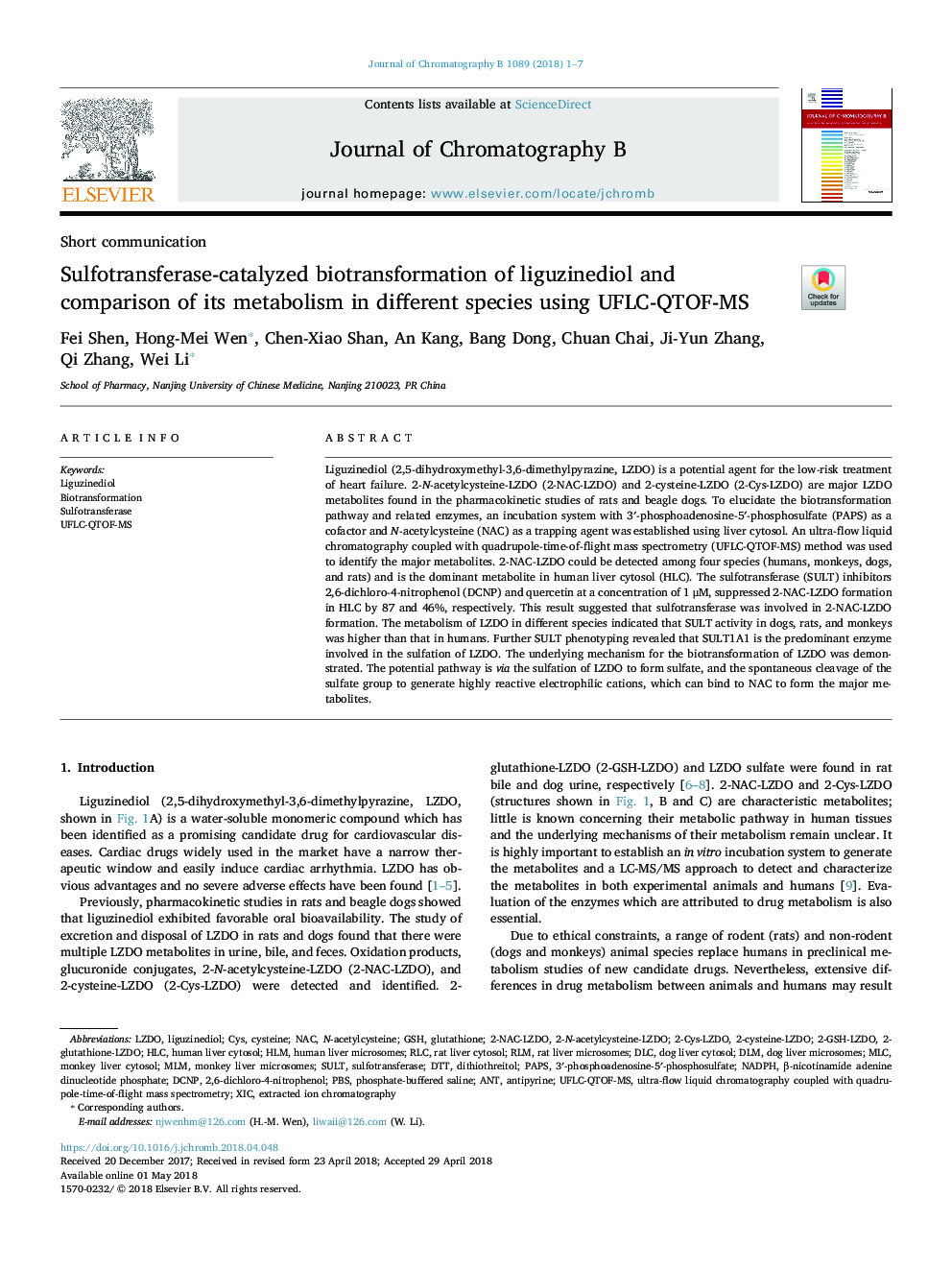| کد مقاله | کد نشریه | سال انتشار | مقاله انگلیسی | نسخه تمام متن |
|---|---|---|---|---|
| 7615006 | 1493981 | 2018 | 7 صفحه PDF | دانلود رایگان |
عنوان انگلیسی مقاله ISI
Sulfotransferase-catalyzed biotransformation of liguzinediol and comparison of its metabolism in different species using UFLC-QTOF-MS
دانلود مقاله + سفارش ترجمه
دانلود مقاله ISI انگلیسی
رایگان برای ایرانیان
کلمات کلیدی
NACMLCMLMHLMDLMHLCRLCDLCCysSULTANTGSHRLMLiguzinediolNADPHDTTDCNPXICPBS2,6-Dichloro-4-nitrophenol - 2،6-Dichloro-4-nitrophenol3′-phosphoadenosine-5′-phosphosulfate - 3'-فسفودوژنسی-5'-فسفسولفاتN-acetylcysteine - N-استیل سیستئینPAPs - PAP هاβ-nicotinamide adenine dinucleotide phosphate - β-نیکوتین آمید آدنین دینکلوتید فسفاتdithiothreitol - دیتیوتریتولBiotransformation - زیستدگرگونیsulfotransferase - سولفوترانسفرازhuman liver cytosol - سیتوزول کبدی انسانیrat liver cytosol - سیتوزول کبدی موشCysteine - سیستئینAntipyrine - ضدپیرینPhosphate-buffered saline - محلول نمک فسفات با خاصیت بافریdog liver microsomes - میکروسوم های کبدی سگRat liver microsomes - میکروسوم های کبدی موشHuman Liver Microsomes - میکروسومهای کبدی انسانیextracted ion chromatography - کروماتوگرافی یونی استخراج شده استGlutathione - گلوتاتیون
موضوعات مرتبط
مهندسی و علوم پایه
شیمی
شیمی آنالیزی یا شیمی تجزیه
پیش نمایش صفحه اول مقاله

چکیده انگلیسی
Liguzinediol (2,5-dihydroxymethyl-3,6-dimethylpyrazine, LZDO) is a potential agent for the low-risk treatment of heart failure. 2-N-acetylcysteine-LZDO (2-NAC-LZDO) and 2-cysteine-LZDO (2-Cys-LZDO) are major LZDO metabolites found in the pharmacokinetic studies of rats and beagle dogs. To elucidate the biotransformation pathway and related enzymes, an incubation system with 3â²-phosphoadenosine-5â²-phosphosulfate (PAPS) as a cofactor and N-acetylcysteine (NAC) as a trapping agent was established using liver cytosol. An ultra-flow liquid chromatography coupled with quadrupole-time-of-flight mass spectrometry (UFLC-QTOF-MS) method was used to identify the major metabolites. 2-NAC-LZDO could be detected among four species (humans, monkeys, dogs, and rats) and is the dominant metabolite in human liver cytosol (HLC). The sulfotransferase (SULT) inhibitors 2,6-dichloro-4-nitrophenol (DCNP) and quercetin at a concentration of 1â¯Î¼M, suppressed 2-NAC-LZDO formation in HLC by 87 and 46%, respectively. This result suggested that sulfotransferase was involved in 2-NAC-LZDO formation. The metabolism of LZDO in different species indicated that SULT activity in dogs, rats, and monkeys was higher than that in humans. Further SULT phenotyping revealed that SULT1A1 is the predominant enzyme involved in the sulfation of LZDO. The underlying mechanism for the biotransformation of LZDO was demonstrated. The potential pathway is via the sulfation of LZDO to form sulfate, and the spontaneous cleavage of the sulfate group to generate highly reactive electrophilic cations, which can bind to NAC to form the major metabolites.
ناشر
Database: Elsevier - ScienceDirect (ساینس دایرکت)
Journal: Journal of Chromatography B - Volume 1089, 1 July 2018, Pages 1-7
Journal: Journal of Chromatography B - Volume 1089, 1 July 2018, Pages 1-7
نویسندگان
Fei Shen, Hong-Mei Wen, Chen-Xiao Shan, An Kang, Bang Dong, Chuan Chai, Ji-Yun Zhang, Qi Zhang, Wei Li,